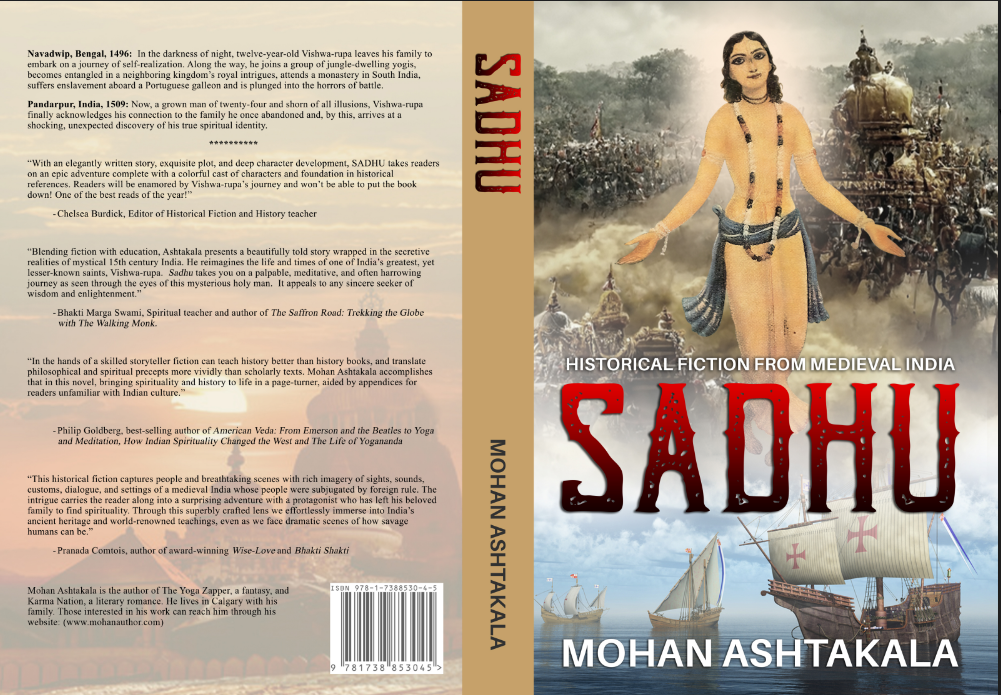New Historical Novel “Sadhu” Offers an Exciting Retelling of the Life of Sri Vishwa-rupa
By Kulavati Krishnapriya Devi Dasi, ISKCON News Staff Writer | Dec 28, 2023

Hari Mohan Dasa (Mohan Ashtakala), an editor and publisher of a community newspaper in Denver, Colorado, for thirteen years, has written an amazing historical fiction titled “Sadhu.” The book has received immense appreciation from authors and devotees. It explores the spiritual journey of Lord Chaitanya’s elder brother, as well as the historical and social intricacies of Medieval India.
In the list of mentioned testimonials, HH Bhakti Marga Swami said, “Blending fiction with education, Ashtakala presents a beautifully told story wrapped in the secretive realities of mystical 15th century India. He reimagines the life and times of one of India’s greatest yet lesser-known saints, Vishwa-rupa. ‘Sadhu’ takes you on a palpable, meditative, and often harrowing journey, as seen through the eyes of this mysterious holy man. It appeals to any sincere seeker of wisdom and enlightenment.”
Pranada Comtois, author of award-winning “Wise Love” and “Bhakti Shakti” said, “This historical fiction captures people and breathtaking scenes with rich imagery of sights, sounds, customs, dialogue, and settings of a medieval India whose people were subjugated by foreign rule. The intrigue carries the reader along into a surprising adventure with a protagonist who has left his beloved family to find spirituality. Through this superbly crafted lens, we effortlessly immerse into India’s ancient heritage and world-renowned teachings, even as we face dramatic scenes of how savage humans can be.”
Currently living in Calgary with his family, Hari Mohan Dasa is also the author of “The Yoga Zapper” and “Karma Nation.” His book, “Sadhu,” is a mesmerizing tapestry that skillfully blends historical intricacies with a touch of magical realism, transporting readers to late 15th-century India. The protagonist, Vishwa-rupa, born in Bengal in 1484, embarks on a spiritual odyssey that unfolds against significant historical events.
The narrative gracefully navigates through Vishwa-rupa’s departure from home, his encounters with sannyasis, and reflections on his transformative journey. Throughout ‘Sadhu,’ the author skillfully weaves themes of spiritual growth, diverse cultural traditions, and the transformative power of devotion. The novel’s unique blend of historical accuracy and magical elements creates an immersive reading experience.
As the story progresses, the novel takes unexpected turns, delving into political turmoil and battles, enriching the plot with layers of complexity. Vishwa-rupa’s internal struggles and unwavering determination serve as a testament to the human spirit’s capacity to endure and evolve, resonating with readers facing their trials and tribulations.
The exploration of Puri and the Jagannatha Temple serves as a vivid canvas, offering readers an authentic glimpse into the spiritual traditions of the time. The author’s attention to detail is evident in the portrayal of diverse landscapes. The novel serves as a bridge between epochs, fostering a profound appreciation for India’s rich historical legacy.
The narrative’s tempo quickens with Vishwa-rupa’s involvement in the Portuguese attack on Honnavar, portraying the intricacies of war and the protagonist’s internal struggles. The subsequent chapters narrate intense battles, vividly capturing Vishwa-rupa’s resilience as he strives to escape captivity. The novel’s thematic richness is further amplified as Vishwa-rupa seeks solace in Pandarpur, guided by the teachings of Sant Tukaram. Profound spiritual moments and contemplation on spiritual progress take center stage, adding depth to the protagonist’s character.
The final chapters unveil spiritual revelations and encounters with Sri Ranga Puri, providing a captivating climax. The epilogue in Pandarpur brings closure to the narrative, with Sri Chaitanya Mahaprabhu learning of his elder brother Vishwarupa’s passing away and embracing the belief in his spiritual perfection.
“Sadhu” acts as a cultural prism, refracting the diverse hues of medieval India. By immersing readers in the sights, sounds, and customs of a bygone era, the book serves as a cultural ambassador. As readers traverse the labyrinthine alleys of Vishwa-rupa’s spiritual journey, they gain insights into the rich tapestry of India’s ancient traditions, fostering cross-cultural understanding and empathy.

“Sadhu” becomes a meditative pause, inviting readers to reflect on their spiritual odysseys. The protagonist’s journey becomes a mirror, prompting introspection and encouraging individuals to seek deeper connections with their inner selves and the world around them.
In essence, “Sadhu” emerges not merely as a historical fiction but as a contemporary guide, offering societal benefits through cultural enrichment, spiritual introspection, and resilience in the face of challenges.
Hari Mohan Dasa (Mohan Ashtakala) is a disciple of Bhaktisvarupa Damodara Swami. If you want to learn more about the author, visit his website. You can also connect with him on Facebook.















